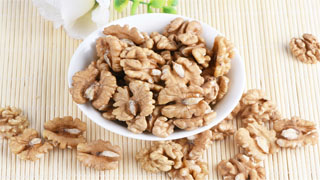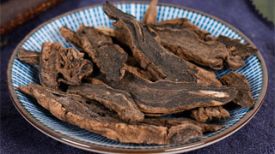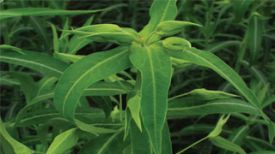
1. Alias
Walnuts, walnut kernels, walnut meat.
2. Plant morphology
Deciduous trees, reaching a height of up to 35 meters. The bark is gray with longitudinal cracks; The small branches have patchy pulp and are hairless. Single feather compound leaves alternate, with dense glandular hairs on the leaf axis; Leaves 5-9, sessile or nearly sessile, ovate, rectangular ovate or elliptical ovate, 5-13 cm long, 2-6.5 cm wide, apex pointed, base rounded, entire, bright green on top, hairless, light green on bottom, with only a cluster of short hairs in the axils of the lateral veins. Flowers are monoecious and grow on the same plant, with male flowers forming drooping cauliflower inflorescences and female inflorescences spikelet like and erect. The drupe is nearly circular in shape, with a fleshy outer skin that is green in color. The inner skin (nucleus) is hard, bony, with a surface that is uneven or wrinkled, and has two longitudinal edges. It is yellow brown in color. The flowering period is from April to May, and the fruiting period is in October.
3. Origin distribution
Widely cultivated in various parts of China, with the highest amount in North China.
4. Harvesting and processing
Harvested in autumn when the fruit is ripe, remove the fleshy skin, sun dry, and then remove the core-shell and woody membrane.
5. Characteristics of medicinal herbs
Multiple broken, irregular blocks with wrinkled grooves of varying sizes; The complete seed is spherical in shape, with a diameter of 2-3 centimeters, uneven, and the seed coat is light yellow or yellow brown, membranous, and the vascular bundles and veins are dark brown. Leaves are white in color. Crispy and rich in oil. Mild aroma, sweet taste; The seed coat has a bitter and astringent taste.
6. Sexual Taste Returning to the Classics
Warm in nature, sweet in taste. Return to the Kidney Meridian, Lung Meridian, and Large Intestine Meridian.
7. Effect and Function
Warm up the lungs and kidneys, relieve asthma and phlegm, moisten the intestines and astringent essence. Belonging to the subcategory of tonifying deficiency medicine, it is a type of tonifying yang medicine.
8. Clinical application
Take 6-9 grams and decoct in water or dissolve into pills. External use: Rub and apply. Used to treat soreness, weakness, coldness, wheezing, cough, nocturnal emissions, erectile dysfunction, and constipation in the waist and knees.
9. Pharmacological research
Anti cancer. Feeding dogs a mixed fat diet containing walnut oil can increase body weight and serum protein, but blood cholesterol levels rise slowly. Its function may be to affect the synthesis, oxidation, and excretion of cholesterol.
10. Chemical composition
Contains fatty oil, mainly composed of glycerides of linoleic acid, oleic acid, and linolenic acid. It also contains protein, carbohydrates, vitamin E, vitamin B2, calcium, phosphorus, iron, carotenoids, brassinosteroids, 1,4-naphthoquinone, riboflavin, etc.
11. Usage taboos
Those with yin deficiency and excessive fire, as well as loose stools and diarrhea, should take it with caution. Those with phlegm fire in the lungs and internal heat accumulation should not take it, and it should not be taken together with strong tea.
12. Compatibility prescription
① Treating kidney deficiency, tinnitus, and nocturnal emissions: 3 walnut kernels, 7 Schisandra chinensis seeds, appropriate amount of honey, chew before bedtime. (Guizhou Herbal Medicine)
② Treating small intestinal gas pain: one walnut kernel. Burn charcoal and grind it into powder, then consume it with hot wine. (The miraculous formula)
③ Treating rib pain: Walnut kernels can be used in any amount without peeling. Boil half a cup of water and half a cup of wine before serving. (Zhu's Collection and Verification Formula)
④ Treating injuries caused by falls: pounding walnut kernels into meat, mixing with alcohol, taking warm meals, and relieving constipation. (Compendium of Materia Medica)
⑤ Treating persistent cough: 50 walnut kernels (cooked and peeled), 150 grams of ginseng, and 350 almonds (stir fried with bran and soaked in soup and peeled). Grind it evenly and refine it into honey. It can make wutong seeds big. Chew one pill per hollow. Under ginseng soup, take it while lying down. (Quoted from "Xiao Dayin Fang" in "Gangmu")
⊙ The content of the article is for clinical reference only. Non TCM professionals are not allowed to test drugs.


